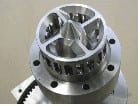 Several manufacturing procedures for chemical, cosmetic, pharmaceutical or food products distribute powder-like solids during the liquid or pasty phases of operations. The systems usually used for these operations require the injection of powders in an agitation tank. Dispersion is often performed by the same tool (located on the bottom of the tank) as the one that insures (if required) the emulsion of liquids/liquefying. The most widely used tool to perform this operation is a single or double cage rotor-stator for basic operations and desired thinness of emulsion.
Several manufacturing procedures for chemical, cosmetic, pharmaceutical or food products distribute powder-like solids during the liquid or pasty phases of operations. The systems usually used for these operations require the injection of powders in an agitation tank. Dispersion is often performed by the same tool (located on the bottom of the tank) as the one that insures (if required) the emulsion of liquids/liquefying. The most widely used tool to perform this operation is a single or double cage rotor-stator for basic operations and desired thinness of emulsion.
Homogenisation of these mixtures is insured by the circulation of liquids in the tank, which can be obtained by two different procedures: (Procedure 1) circulation inside the tank or (Procedure 2) recirculation using piping outside the tank.

The injection of powders is performed using two different procedures:
- Vacuum (Procedure 1): evacuation of the tank allows the injection of powders during the liquid phase contained in the tank
- Venturi (Procedure 2): the start-up of the emulsifier generates a fixed flow in the recirculation piping for the injection of powders
Each system presents limitations that the solution developed by VMI-Rayneri (currently patent pending) will resolve. This innovation is based on the vacuum injection of powders directly into the center of the emulsifier as illustrated below:

The main drawback of one or the other conventional procedures is the simultaneous action of two distinct hydrodynamic states in the tank to insure the dispersion of particles and homogenisation during liquid phases.
The fact that the vacuum injected powders do not enter the emulsifier directly increases the risk of preferential transition of powders during the liquid phase resulting in the loss of materials to disperse. This inconvenience can also cause an increase in cleaning procedures caused by the eventual accumulation of powder deposits under the cover.
Injection in the center of the emulsifier as suggested by VMI-Rayneri allows a greater range in vacuum levels than those offered by conventional systems without any risk for the powders to go through the liquid phase without being dispersed. This procedure allows a substantial increase in output insuring a higher production rate.
For Procedure 2, the presence of a recirculation loop outside the tank creates zones that are difficult to access, difficult to clean and a limited circulation output specifically during the incorporation of powders in a viscous or very pseudo-plastic medium. This limitation makes these systems very inefficient during dispersion, homogenisation or thermal transfer procedures. Operations that are essential for the manufacturing of several products for which the paramount criteria is the circulation output and not only the shearing capacity of the emulsifier.
The solution suggested by VMI-Rayneri, which is different from all conventional systems allows the elimination of a perfectly established state of flow (laminar state) around the emulsifier to insure an optimal injection of powder. Since solid particles are injected directly in the center of the rotor-stator, the quality of dispersion insured by the emulsifier is completely independent of the circulation of fluids in the tank and linked to functions other than the dispersion itself. Each tool in the tank is therefore used for only one specific mixing action. The result is an increase in performance and productivity of the group.
The use of a rotor/stator integrated with vacuum injection is complete when used with pendulum agitation, creating an efficient flow of the mixture in the tank that is not hindered by the output generated by the emulsifier. In this manner the unit becomes a production tool capable of insuring multiple phase activity:
- dispersion of powders,
- emulsion of fatty phases, during W/O emulsion as well as O/W emulsion,
- dispersion, homogenisation and thermal transfer without the need of shearing, notably for the final phases of cosmetic product processing.
VMI-Rayneri therefore offer users an enhanced multiple use tool which allows the same production efficiency for body treatment creams, masks as well as mascaras using the same mixer.
In addition, the capacity of using wider ranges of vacuum than what is usually offered by conventional systems allows quicker commissioning as well as increased productivity thanks to more simple, immediate and less frequent adjustments of vacuum levels.
To summarize, it is proven that vacuum injection in the center of the emulsifier as implemented by VMI-Rayneri offers a superior quality of dispersion and emulsifying procedures compared to the ones obtained by using conventional systems. Mixers equipped with this new technology become high performance production tools offering increased versatility and productivity.